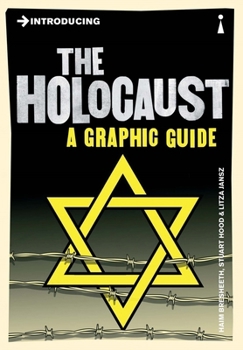Introducing the Holocaust: A Graphic Guide
(Part of the Graphic Guides Series and Introducing Graphic Guides Series)
Select Format
Select Condition 
Book Overview
'Excellent ... an astounding amount of material.'
Times Educational Supplement
Popular culture often portrays the Holocaust as a
horrific drama played out between Nazi executioners and ghetto Jewish victims -
in short, a single aberration of history.
Introducing
the Holocaust is a powerful graphic guide that dissolves this
stereotype, explaining the causes and its relevance today. It places the
Holocaust...
Format:Paperback
Language:English
ISBN:1848315147
ISBN13:9781848315143
Release Date:May 2013
Publisher:Icon Books
Length:176 Pages
Weight:0.38 lbs.
Dimensions:0.6" x 4.6" x 6.5"
Customer Reviews
2 ratings
The Holocaust is an event that everyone should study and this book is an excellent first step
Published by Thriftbooks.com User , 16 years ago
Given the enormous amount of evidence and that the events are historically recent, it is incredible that there are people who doubt that the Holocaust took place. Thousands of German, Austrian, Hungarian, Romanian, Italian and other Nazi satellite troops were eyewitnesses to the roundup and slaughter. Although millions died, thousands survived the camps and their stories are identical in all the essential details. Finally, there is the complete absence of so many people of the particular ethnic and racial groups that were to be exterminated. The only way this movement to cast doubt on the Holocaust can be fought is to make sure that it is never forgotten. To do that, every person must be educated as much as possible about the mechanized killing that took place in Europe in World War II. This book is an excellent introduction to this difficult topic; in a combination of facts and basic conclusions, the authors set down the events in detail. Some of the failures of the opponents of Germany to provide refuge to the Jewish refugees are also examined. Most of the excuses put forward to justify denying the refugees' asylum will forever be a black mark on many countries. Concerted action by other nations to simply accept them would have done a great deal to prevent the wholesale murder. Furthermore, the additional wealth and talent the refugees would have provided would have strengthened the Allied cause when the war came. Ironically, there is a great deal of evidence to indicate that Hitler and the Nazis would have preferred that solution. The authors also spend some time on explanations of how a people could have been systematically killed by civilized people. Unfortunately as they point out, the Holocaust was an aberration only in terms of the numbers and methods, it was a continuation of a centuries old policy. They close the book with a mention of the nation of Israel and why, in the minds of Jews, it must exist and be unconditionally supported. It is an important section, as it helps explain the rigidity of positions in the ongoing Arab-Palestinian conflict.
Mostly Factual, Clear, Concise
Published by Thriftbooks.com User , 23 years ago
As part of my teacher training, I am developing a bibliography of materials to be shared with 65 colleagues in a Children's Literature Course. I have listed this book as a general reference to a Holocaust unit designed with sixth and seventh graders in mind for its clear language, and the forward moving progression of the text. The words do now flow necessarily, but the feel is of a steady march toward the culmination of the book. The disembodied collage-effect of the illustrations, strictly black and white, gives power to the text. Intermittant negative imaging of white text on a black background also lends weight and tone to the text. Visually, it is not a comfortable read, as it should be, artistically speaking.I have a problem with one aspect of the background information in the beginning of the book. The lack of historical background of eugenics work (pages 16-17)in the United States seems irresponsible. This ommission leaves the impression that only Britian and Germany developed eugenics. The United States during the mid-1800's into the early 1900's had a large piece of that terrible legacy. German "scientists" borrowed heavily from American research. Americans need credit regarding our share of responsibility for irresponsible medical practices, if fingers are to be pointed.Otherwise this book responsibly covers a large amount of information in a very critical efficient manner.






